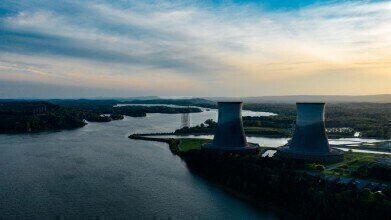News & Views
When Will We Achieve Self-Sustaining Nuclear Fusion?
Feb 06 2015
Researchers were one step closer in achieving self-sustaining nuclear fusion last week, as scientists managed, for the first time, to release more energy than they put in. But first…
What is nuclear fusion?
Nuclear fusion is the energy that powers the Sun, and if harnessed properly, could provide an unlimited source of clean and sustaining energy. The problem is that any experiment in nuclear fusion has always required more energy than it produced.
However, in a breakthrough experiment carried out in California, scientists managed to reach a critical threshold in which more energy was produced than was put in.
The breakthrough experiment
The experiment was carried out at the Nuclear Ignition Facility (NIF) based at Lawrence Livermore National Laboratory. The experiment used laser beams to compress a tiny pellet made of fuel that measured half the width of a human hair.
The fuel pellet consisted of two hydrogen isotopes - tritium and deuterium, which are derived from water. When these isotopes are placed under enormous pressures and temperatures for a short time they release energy.
“We are fusing deuterium and tritium, which are isotopes of water, in a way that gets them to run together at high enough speed to overcome their natural electrical repulsion to each other,” said Omar Hurricane of the Livermore laboratory.
The crucial element
The experiment went through many changes before the breakthrough at NIF. The laser pulses had to be altered several times to ensure the fuel pellet was compressed evenly.
“We had to compress the capsule by 35 times. This is like saying that if you started with a basketball it would be like compressing it down to the size of a pea, but keeping the perfect spherical shape, which is very challenging,” Dr Debbie Callahan said.
After many attempts, the team at NIF discovered that in order for the nuclear fusion to work, the compression has to be high and uniform, and then fusion will occur.
Fusion vs. Fission
This method is noticeably different from current operating nuclear power plants, which use fission or splitting atoms, rather than compressing or squashing them to create energy.
The problem with nuclear fission is that this uses uranium which when mined can cause harm to the environment. It also leaves behind toxic waste that is extremely difficult to get rid of.
Other types of fusion
Nuclear fusion is considered to be a cleaner, greener energy source and several projects around the world, including the ITER facility in Cadarache, France, are already under construction.
This facility will use a different method of extracting energy from fusion fuel sources, known as magnetic confinement. In a special donut shaped reactor, a stream of hydrogen gas is heated by electricity, neutral particle beams and microwaves. The gas then turns into plasma which gets squeezed by the magnets and fusion occurs.
But don’t get excited too soon about nuclear fusion, word is that construction on the ITER facility won’t finish until 2019.
Looking back…
Back in 2010 at Science World – The Fisher Scientific Laboratory Experience visitors were treated to two thought provoking seminars from Lord Professor Robert Winston and Professor David Bellamy. As part of these seminars, the development of lasers were considered, looking at how they have accelerated advances in medicine, played a positive role in the development of DVD’s and even alllowed us to attempt nuclear fusion. For more information on this fascinating discussion, read: Prominent Speakers Captivate Audience.
Digital Edition
Lab Asia 31.2 April 2024
April 2024
In This Edition Chromatography Articles - Approaches to troubleshooting an SPE method for the analysis of oligonucleotides (pt i) - High-precision liquid flow processes demand full fluidic c...
View all digital editions
Events
Apr 22 2024 Marrakech, Morroco
Making Pharmaceuticals Exhibition & Conference
Apr 23 2024 Coventry, UK
Apr 23 2024 Kintex, South Korea
Apr 23 2024 Seoul, South Korea
Apr 24 2024 Jakarta, Indonesia








.jpg)









